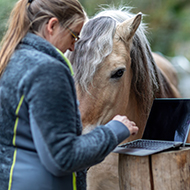Study to investigate cause of Dalmatians’ spots
Melanocytes interact with skin and hair to create pigmentation patterns.
A new study is to conduct the first biological and mathematical investigation into the cause of Dalmatian’s signature spotted patterning.
The four-year collaboration between the University of Bath and Lancaster University, with support from the Kennel Club, is hoping to understand how the spot pigments cells are born and migrate as the Dalmatian embryo develops.
The development of distinct patterning, such as spots, patches and stripes, is caused by pigment-producing cells. These cells, known as melanocytes, interact with skin and hair to create a pattern.
In the case of the Dalmatian the spots are irregular patches of melanocyte-populated hairs, on its melanocyte-absent coat.
However, although there is a good understanding of the genetics involved in pigmentation, less is known about how the patterns are formed.
By investigating the nature of melanocytes, researchers also expect to better understand the developmental processes of mammals more broadly. This is because the genes involved in pigmentation are closely involved in the early stages of mammal life – such as immune systems and behavioural traits.
A team of scientists will utilise both experimental and mathematical modelling, as they attempt to ascertain the link between Dalmatian genetics and coat patterns.
The project, Spot the Difference: The Cellular and Clonal Basis of Dalmatian and Mouse Spots, will be led by Dr Richard Mort, from Lancaster University. He will work with Dr Barbara Shih, a bioinformatician at Lancaster, and Dr Kit Yates, a mathematician from University of Bath.
It is supported by £498,000 in funding from the Leverhulme Trust.
Developmental biologist Dr Mort said: “The impact of human selective breeding has resulted in some striking pigmentation in domestic animals.
“Dalmatians, with their characteristic spotting patterns, have long fascinated breeders, geneticists, and developmental biologists.”
Dr Yates said: “We will, for the first time, build a comprehensive mathematical model of mammalian pigmentation.
“This model will serve not only as a framework to explore the full gamut of pigmentation patterns in nature but also as a paradigm for wider efforts to generate digital organ systems and eventually whole organisms.”
Image © Shutterstock



 With Strangles Awareness Week just around the corner (5-11 May), vets are being encouraged to share a survey about the disease with their horse-owning clients.
With Strangles Awareness Week just around the corner (5-11 May), vets are being encouraged to share a survey about the disease with their horse-owning clients.